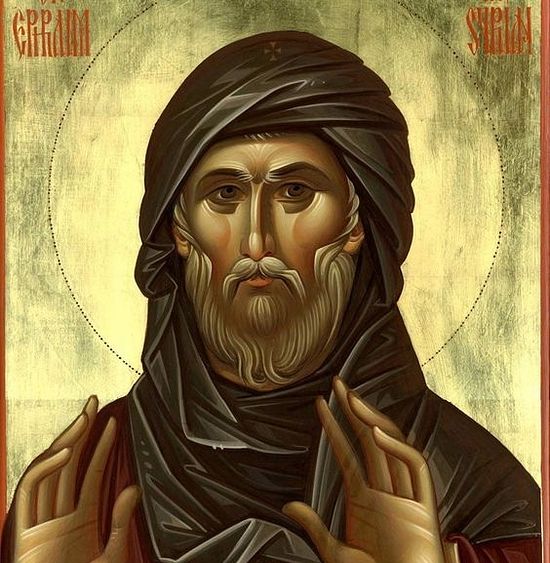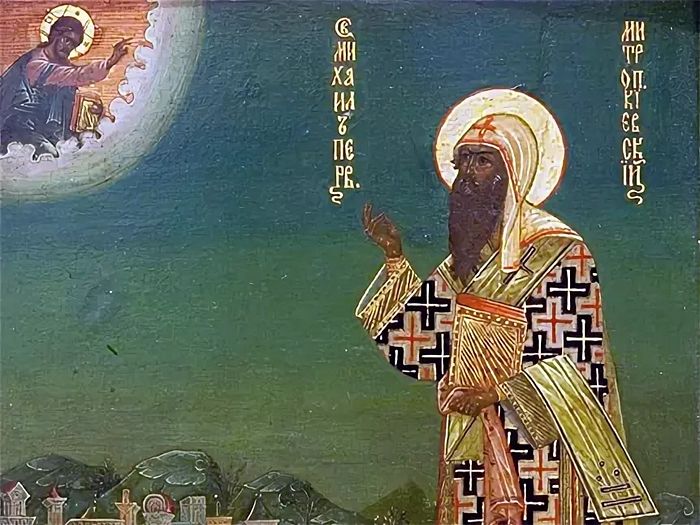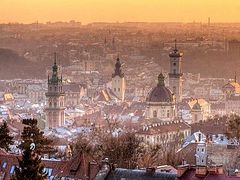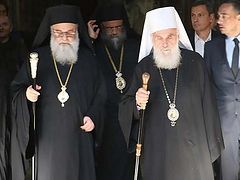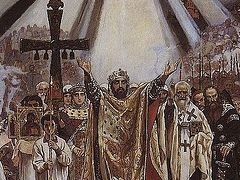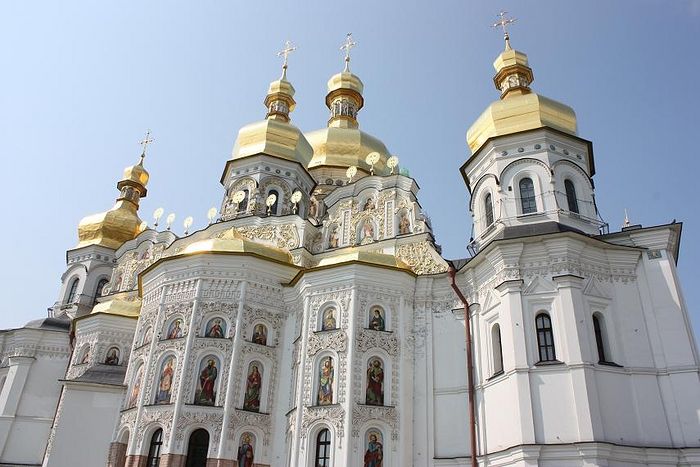 The Dormition Cathedral of Kiev Caves Lavra
The Dormition Cathedral of Kiev Caves Lavra
Introduction by Matfey Shaheen:
Would it surprise you to know that Syria, Ukraine, and all Rus’ belong to Western Civilization? If we define Western Civilization as it was classically understood to be: 1.) Greek Philosophy, 2.) Roman Law, and 3.) Christianity, we would see that Russia by that model, is more Western than the contemporary “West”, which from the French revolution onward ideologically rejected Christendom. But where did Rus’ inherit this belonging to Christendom?
Kievan Rus’ received Orthodoxy “from the Greeks”, but Syria, at that time was no less Hellenic than Athens. Antioch was a capital of Christian, Greco-Roman Civilization—the homeland of St. John Chrysostom. According to Scripture, Antioch—Syria is also the birthplace of the very word “Christian”. Andre Parrot, director of the Louvre even famously declared, “Every man has two homelands: his own, and Syria”.
Today in Syria and Ukraine, we are witnessing the strongest clash between the classical Christian West, and the anti-Christian modern West. But did you realize these lands are intimately related? The first Metropolitan of Kiev was from Syria, and St. Raphael of Brooklyn, the first bishop consecrated in America, studied in Kiev. The Assyrian Archimandrite Seraphim Bit-Kharibi, also studied there, and dedicated a powerful chant of Psalm 50 to “his beloved Ukrainians”, in his native Aramaic—the language of Jesus Christ. All this reveals one fact: Syrians and Ukrainians are not friends—we’re family.
Far yet so close. Seven points of connection between Ukraine and Syria
Kievan Rus’ since the time of her reception of Christianity, has possessed a direct relationship with the Church of Antioch, and the ancient people of Syria. Yet so few realize that the very first Metropolitan of Kiev (988-992) was a Syrian—and yet this is a historical fact.
Here are seven reasons why Syria and Ukraine are closer than you think:
№1—Syria is the cradle of Christianity
Despite the fact that the Antiochian Church was located far enough from the Ukrainian lands, and communication in past times was difficult, the spiritual connections between Christians from our countries has never been broken. It is difficult to overestimate the importance and authority of the Church of Antioch for us and our ancestors. After all, the very word “Christian” first appeared in Antioch according to the Book of Acts[1].
Christ did not speak in Ancient Hebrew, he spoke Aramaic, the very same language which today we often call the Ancient Syrian Language [or Syriac—Trans.]
Saint Basil the Great said, “What is more important for the Ecumenical (Universal) Church than Antioch? She is the head (κεφαλή), which in the field of health, also tells of the whole body.”
How important is this for us to hear now, in the context of the ambitious plans of the Patriarchate of Constantinople, and their desire for absolute primacy in the management and hierarchy of all others. Indeed, in the words of a truly ecumenical theologian and teacher, we see a comparison in the spiritual meaning of that word, and not the primacy of one Local Church and its right to rule and command others.
Orthodox Syrians of antiquity had a huge impact on our Christian consciousness and worldview. After all, is it possible to imagine Great Lent without the penitent prayer of Saint Ephraim the Syrian? Is it possible to imagine our church heritage without his sermons and thoughts? This is evidenced by the many translations and publications of the works of Saint Ephraim, which existed in Rus’.
Ephraim the Syrian managed throughout the centuries, and for almost a millennium, to impress the souls of the Slavs so much, that they received him as “their own”. Church historians note the influence of Saint Ephraim the Syrian on Russian literary monuments, for example, in the Sermon on Law and Grace, by Saint Hilarion, Metropolitan of Kiev. For Kievan Rus’, the works of the Syrian author cannot be compared in popularity with any other spiritual writer, although there were also the works of the famous church authors Isaac the Syrian, Saint John of Damascus, and others.
№2—The First Metropolitan of Kiev was Syrian
According to Church tradition, Metropolitan Michael of Kiev was a contemporary of Equal-to-the-Apostles Prince Vladimir of Kiev, and arrived in Chersonesus for his baptism with several priests and bishops, and later went to Kiev to baptize and educate the Kievan people.
Initially, members of the royal family and boyars were baptized by the Holy Hierarch, and then all the people gathered in the Dnieper.
Such information is not based on empty claims, but thanks to an ancient document called the Church Statute of Prince Vladimir, and also in concordance with the Joachim Chronicle, which all indicate that Metropolitan Michael was from Syria.
Metropolitan Michael was an active preacher, and blessed the prince to build the Church of the Tithes in Kiev, in honor of the Dormition of the Most Holy Mother of God. In this church, he was later buried. Over time, his relics were transferred to the Near Caves of the Kiev Caves Lavra, and in 1730, the relics of Saint Michael were transferred to the great Dormition Cathedral of the Lavra.
The first Metropolitan of Kiev was distinguished by [his] piety, in some of the chronicles, he is called a man of great wisdom and holy life. In the synodic of the Cathedral of Holy Wisdom in Kiev (Saint Sophia’s), he is rightly called the first originator [among the Russian hierarchs—Trans.]
Metropolitan Michael is also credited with the construction of St. Michael's Golden-Domed Monastery, and the monks who arrived with him founded Mezhyhirya Savior-Transfiguration Monastery[2].
The veneration of the saint dates back to ancient times. Written evidence of this includes the decree of the Holy Synod of 1762, which blessed the printing of services to the venerable Michael, Anthony, and Theodosius, and other wonder-workers of the Caves, in books published by the Lavra printing house. His name was included in the general Menologion as such: our Church celebrates the memory of the Syrian saint on June 15 and September 30.
The relics of Saint Michael were kept in Dormition Cathedral of Kiev Caves Lavra, but after it was blown up in 1941, the priceless relics were lost forever.
In Kiev there is a church in honor of the Holy Hierarch Michael; in the 1890s, it was built on the territory of the Alexander Hospital. In the 1930s, the church was destroyed, and in 2000, it was rebuilt in its original form.
№3—Syrians in Rus’
As Orthodoxy became established in Rus’, foreigners from Christian countries began to appear, including Orthodox Syrians. One such example is known from the Kievan Cave Patericon.
The first Russian prince to become a monk, St. Nikolai Svyatosha (in the world Svyatoslav of Lutsk of Volhynia), the son of the prince of Chernigov David, and great grandson of Yaroslav the Wise had a devoted friend, a doctor from Syria named Peter.
Once, St. Nikolai told him that within three months, he would pass on to the other world, to which Peter was greatly saddened and begged the Lord to allow him to die for Nikolai instead. The Saint then told him to take the monastic tonsure, after which, Peter remained in prayer for three months.
Having communed the Holy Mysteries, the Syrian reposed. Prince Nikolai spent another thirty years in the brotherhood of the Kiev Caves Lavra.
№4—The coming of Antiochian Patriarchs to Ukraine
A very important part of our shared church history is the coming of Antiochian Patriarchs to Rus’. There were two such trips, and the first one was the journey of Patriarch Joachim V in 1585-1586. His goal was to collect alms from the Slavic princes for the Patriarchates and fellow Christians, due to the fact that the Middle East was occupied by Moslems, and the position of the Patriarchate was very dire.
While traveling through the territory of modern-day Ukraine, Joachim V approved the charter of the Orthodox Lviv Brotherhood, and supported it in its confrontations with local church authorities, who were behaving improperly and violating [the canons] of Church life.
In Galicia, he took an active part in the life of the [Kievan] Western Russian Metropolia. The Lviv Brotherhood received the freedom and right to oversee the life of the clergy and laity, and to protect church canons.
Two of his letters written in Arabic and addressed to the Lviv flock have survived. He published an appeal to the Orthodox Western Russian lands urging them to support the Lviv Brotherhood School and printing house.
In the seventeenth century, the land of the Cossacks was visited by Antiochian Patriarch Macarius, and his son, Archdeacon Paul of Aleppo, who made interesting notes in Arabic, in which he described the features of the church life of [Rus’ people].
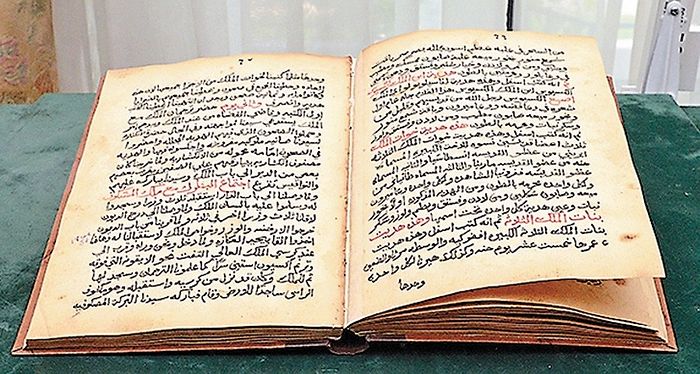 The Journey of Patriarch Macarius to Russia.
The Journey of Patriarch Macarius to Russia.
These works are known to us as The Journey of Patriarch Macarius to Russia. Much was surprising and extraordinary for him in the Slavic land, but thanks to his interest and observations, Rus’ people themselves know a great deal about their history.
Passing through the territory of present-day Ukraine on a journey in 1654, the Patriarch visited Kiev Caves Lavra, the Hetman’s capital Chyhyryn in Subbotov, where the residence of Hetman Bohdan Khmelnitsky was located, and the city of Bohuslav.
The Syrians met with the Hetman himself twice during their trip. They also visited monasteries in the city of Putivl, and Holy Trinity Hustynsky monastery in the lands of Chernigov.
An excellent description of Hustynsky monastery was recorded in the Syrian records. The high-ranking dignitaries were especially struck by the beauty of the iconostas of the Trinity Church, which they considered to be the best, most beautiful in the world.
Patriarch Macarius of Antioch also visited the St. Sophia Cathedral of Kiev. The Syrian guests saw the cathedral [as it was beautified], after the recently completed restoration work undertaken by the Holy Hierarch Peter Mohyla.[3] Among the records, there was a particularly noteworthy remark: Sccording to the people of Kiev, after the invasion of Batu Khan, St. Sophia was desolate for around one hundred years, and livestock were even kept in it.
In the Syrian chronicles, there is a unique and one-of-a-kind description of Dormition Cathedral as it was [after St. Peter Mohyla’s restoration work—Trans.], before the fire which later occurred in 1718.
The Syrian chroniclers wrote thus about Kiev Caves Lavra, and about the Kievan-Rus’ lands in general: “From the very moment when I saw the caves monastery, joy never left me. Our souls were filled with joy. The land of the Cossacks is, in a word, native unto us.”
№5—Pilgrimages to the holy sites of Syria
People from Ukraine also visited the Middle East and Syria during pilgrimages. It is known that in 1729, the Kievan Pilgrim, writer, and publicist Grigorovich-Barsky (the brother of a famous architect) traveled to the Middle East, and went around the whole of Syria. He developed a close relationship with the Patriarch of Antioch, Sylvester, who in 1734 tonsured him a monk with the name Vasily in Damascus.
His main works were travel notes, in which he described the history, nature, life, customs, holy sites, and life of the Church of Antioch in the modern period, in particular the Antiochian monasteries.
№6—A future Patriarch of Antioch, and Saint Raphael of Brooklyn studied in Kiev
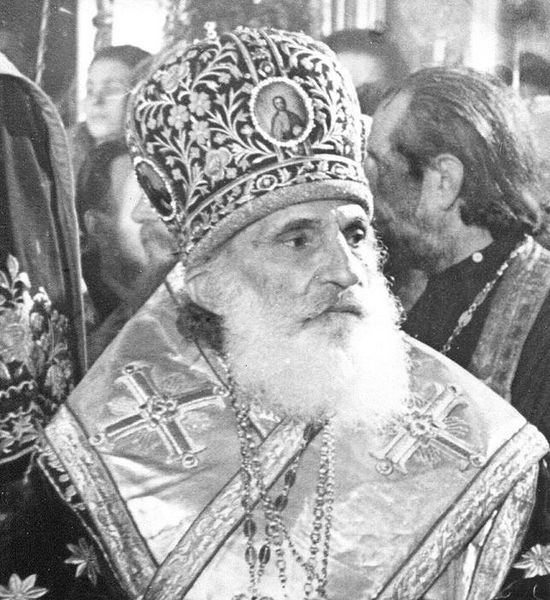 Patriarch of Antioch and all the East, Alexander III (Takhan)
Patriarch of Antioch and all the East, Alexander III (Takhan)
Syrians also studied in Kievan theological schools. It is known that the first Syrian envoy to the Kiev Theological Academy in 1863, was the student Mussei Niphont, who in 1867, successfully completed the full academy course. One of the most famous students at the Kiev Theological Academy was the future Patriarch of Antioch and all the East, Alexander III (Takhan). From 1897 to 1900, he studied at the Kiev Theological Academy, and in 1903, Metropolitan St. Vladimir (Bogoyavlensky) elevated him to the rank of Archimandrite.
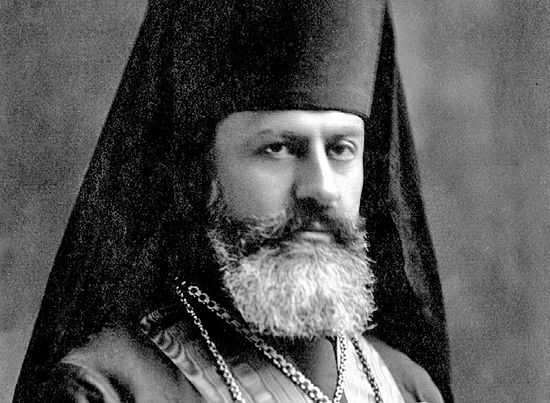 St. Raphael (Hawaweeny). Photo: ru.wikipedia.org
St. Raphael (Hawaweeny). Photo: ru.wikipedia.org
We must also mention Bishop St. Raphael (Hawaweeny), who was canonized a saint by the Orthodox Church in America. He also studied at the Kiev Theological Academy. In the church of the Brotherhood monastery, he was ordained as a hieromonk by then rector of the Academy, Bishop Sylvester.
Metropolitan Elyia (Karam) of Byblos and Botris and Mount Lebanon came to the territory of the USSR multiple times at the invitation of Patriarch Alexiy I; he traveled to Kiev and Odessa. Metropolitan Elyia linked the revival of the Russian Church with the fate of Universal Orthodoxy, repeatedly calling the Rus’ people in his sermons “the beloved people of the Lord”. The tradition of the miraculous intercession of the Theotokos for Russia [during WW2] is also connected with the name of Metropolitan Elyia.
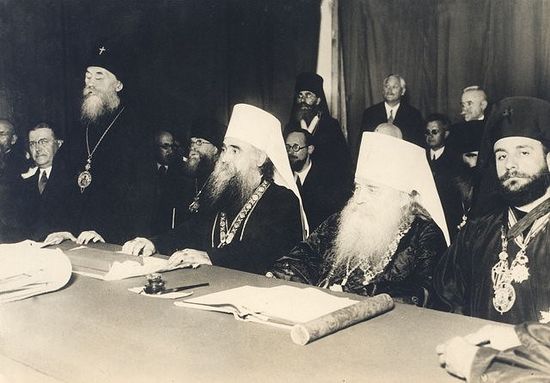 Metropolitan Elyia (Karam) on the far right together with Metropolitan of Kiev and Galicia Anthony (Khrapovitsky) spiritual father of Saint John of Shanghai, and First Hierarch of the ROCOR.
Metropolitan Elyia (Karam) on the far right together with Metropolitan of Kiev and Galicia Anthony (Khrapovitsky) spiritual father of Saint John of Shanghai, and First Hierarch of the ROCOR.
Many other hierarchs of the Antiochian Church also visited the USSR, including Metropolitan Elyias (Salibi) of Beirut. After the death of Patriarch Alexander III, Theodosius VI was elected to the throne of Antioch, and soon after he conducted a visit to several cities within the territory USSR, including Kiev and Odessa.
№7—The Twenty-First Century
In the modern period, there is also much in common between Ukraine and Syria. In both countries there is a war, there are refugees—people fleeing and displaced from their homes, and religiously speaking—not everything is going smoothly either to say the least.
As in Ukraine, where there is a schism within Orthodoxy, so also in Syria there are difficult situations between Sunnis and Shiites. Aside from the (Greek) Orthodox Patriarchate of Antioch, there are also the Jacobites, Maronites, Syro-Catholics, other Melkites, Armenians, etc. Both Syria and Ukraine must go through all these trails which have befallen them in this period of history, both states are in danger of division and separation.
The events uniting our peoples today are mostly tragic, but time does not discriminate [between periods of troubles] and times when everything is simpler. Common Faith and common troubles help us to feel each other’s pain more sharply, which means we come closer to one another and to God.
Today in Ukraine there is a Christian diaspora of Syrians, the majority of whom live in Odessa, Kharkov, and Kiev. Those living in Odessa can participate in divine services at Holy Trinity Cathedral, where they can receive spiritual nourishment from a priest who knows Eastern languages and traditions. During the Liturgy, special petitions are made in Arabic in the cathedral, so that believers can fully participate in the prayer life of the parish.
In 2017, a Bishop of the Antiochian Orthodox Church Qais (Sadiq) visited Kiev, where he served with His Beatitude, Metropolitan Onuphry of Kiev and All Ukraine, and the clergy of Kiev Caves Lavra. During the construction work on Resurrection Cathedral, after the liturgy there was a meeting of the Syrian diaspora with priests of the Ukrainian Orthodox Church. Together with the Kiev Metropolia, the [Syrian] Bishop developed the pilgrimage program “Ukraine: The Garden of Holy Confessors”, so that the Christians of Syria, Lebanon, and Jordan could come and worship in Ukrainian holy sites, and beside the relics of Ukrainian ascetics.
Of course, this is not a complete list of the common ground between our lands. May God grant that the Orthodox ties of Syria and Ukraine strengthen every year, according to the words of the Antiochian Bishop Qais (Sadiq): “Ukraine is a continuation of Antioch, and Antioch is the depth of Ukraine.”

